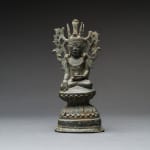Shan Bronze Sculpture of Buddha as the Subduer of Jambhupati, 18th Century CE
Bronze
21.6 x 6 cm
8 1/2 x 2 3/8 in
8 1/2 x 2 3/8 in
FZ.433
Further images
The Shan people are a distinct ethnic group that today constitute Myanmar’s largest minority group. However, from the 13th until the 16th Century, they dominated most of the country. They...
The Shan people are a distinct ethnic group that today constitute Myanmar’s largest minority group. However, from the 13th until the 16th Century, they dominated most of the country. They are largely Buddhist, and their language and customs are closely related to the Thai and Laotians their neighbors to the south and east. In the 19th Century, long after their power had eroded, they were distributed among thirty petty states that paid tribute first to the Burman King, then to the British. This arrangement remained more or less in tact until 1922 when the Federated Shan States were joined together. In 1947, a unified Shan States was created under the Burmese Constitution. Although much of their autonomy has been relinquished to the central government, the Shan retain their unique cultural identity and ethnic heritage.
This specific type of Buddha, which is unique to Myanmar in the oeuvre of Buddhist art, is know as the Subdoer of Jambhupati. The flamboyant headdress with wing-like flanges that crowns the Buddha’s head is the hallmark of this type, which became particularly popular from the late 18th Century onwards. Although the Buddha wore only monastic robes, his luxurious adornments can be explained by an ancient legend recorded in Pali texts. A powerful king named Jambhupati once threatened to annex the neighboring territory of King Bimbisara, who was a friend of the Buddha. Buddha sent his follower Sakka to bring forth King Jambhupati before him for admonition. Meanwhile, the Buddha miraculously commanded a magnificent palace to be constructed in one night and he took his seat upon a jeweled throne dressed in splendid robes. When Jambhupati was brought in to meet him, he was so overwhelmed by the wealth and power of the Buddha that he renounced his kingdom and became a monk.
Poised on a large lotus throne in the characteristic seated virasana position of meditation, this stunning bronze sculpture of the Buddha as the Subdoer of Jambhupati emanates a remarkable spiritual beauty and force that is timeless in its ability to move the beholder as it once moved the tyrant King. Each graceful hand forms a mudra, the mystical ritual gestures that signify various powers. The right hand is in bhumisparsa mudra, the gesture of fearlessness, while his left hand is in dyana mudra, the gesture of meditation. Elaborate ornamentation decorates the Buddha’s body, including bracelets and a beaded necklace, and an elaborate crown with undulating flanges. The treatment of the flanges is somewhat unique in Buddhist art and has its closest counterparts in the Hindu Chola bronzes of Southern India. With his softly modeled facial expression and ethereal body gestures, this sculpture of the Buddha gives us the sensation of his dramatic power and mystical serenity that once converted King Jambhupati. Such a complex and masterful work of art is truly a glorious experience to behold.
This specific type of Buddha, which is unique to Myanmar in the oeuvre of Buddhist art, is know as the Subdoer of Jambhupati. The flamboyant headdress with wing-like flanges that crowns the Buddha’s head is the hallmark of this type, which became particularly popular from the late 18th Century onwards. Although the Buddha wore only monastic robes, his luxurious adornments can be explained by an ancient legend recorded in Pali texts. A powerful king named Jambhupati once threatened to annex the neighboring territory of King Bimbisara, who was a friend of the Buddha. Buddha sent his follower Sakka to bring forth King Jambhupati before him for admonition. Meanwhile, the Buddha miraculously commanded a magnificent palace to be constructed in one night and he took his seat upon a jeweled throne dressed in splendid robes. When Jambhupati was brought in to meet him, he was so overwhelmed by the wealth and power of the Buddha that he renounced his kingdom and became a monk.
Poised on a large lotus throne in the characteristic seated virasana position of meditation, this stunning bronze sculpture of the Buddha as the Subdoer of Jambhupati emanates a remarkable spiritual beauty and force that is timeless in its ability to move the beholder as it once moved the tyrant King. Each graceful hand forms a mudra, the mystical ritual gestures that signify various powers. The right hand is in bhumisparsa mudra, the gesture of fearlessness, while his left hand is in dyana mudra, the gesture of meditation. Elaborate ornamentation decorates the Buddha’s body, including bracelets and a beaded necklace, and an elaborate crown with undulating flanges. The treatment of the flanges is somewhat unique in Buddhist art and has its closest counterparts in the Hindu Chola bronzes of Southern India. With his softly modeled facial expression and ethereal body gestures, this sculpture of the Buddha gives us the sensation of his dramatic power and mystical serenity that once converted King Jambhupati. Such a complex and masterful work of art is truly a glorious experience to behold.





